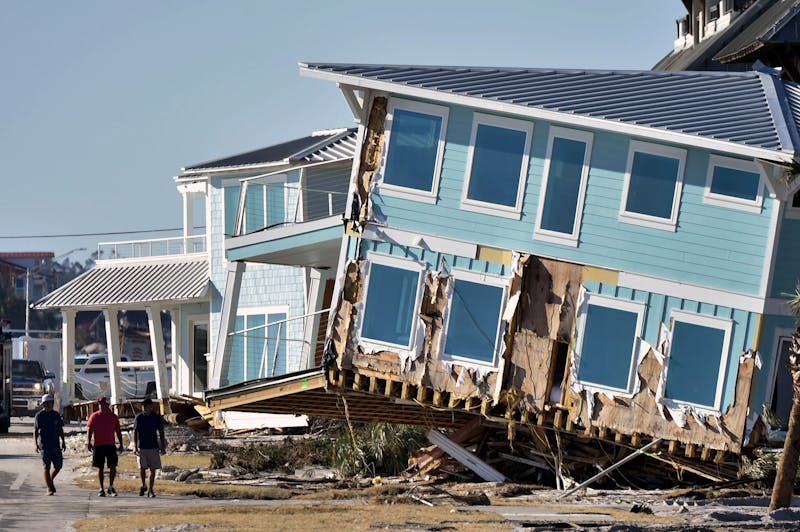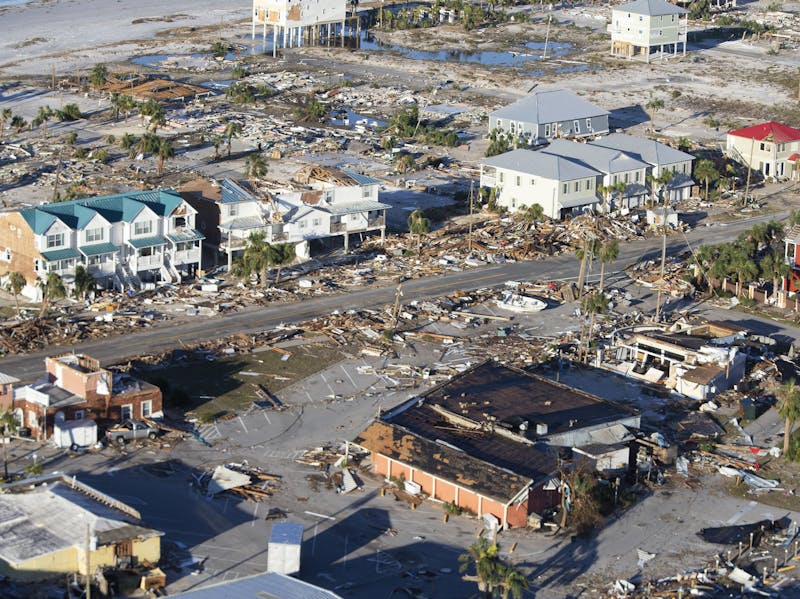CNN journalist Brooke Baldwin struggled to describe what she was seeing from a helicopter flying over Mexico Beach on Thursday. “It’s gone,” she said. “It’s gone.”
Scenes of devastation from the Florida town have become the visual marker of Hurricane Michael, the third-strongest hurricane to ever hit the United States. With wind speeds of up to 155 miles per hour and a nine-foot storm surge, Michael essentially flattened Mexico Beach, leaving behind mountains of trash and two-by-fours. As of Sunday, search-and-rescue teams were still combing through the rubble there, and at least 46 people remained unaccounted for. Mexico Beach’s entire population is only about 1,200; around 280 people stayed to ride out the storm.
There is still hope for the 46 missing. Only one death has been confirmed in the town so far, leaving officials to believe that many who decided to stay may have fled at the last minute as Michael rapidly intensified. Still, when President Donald Trump visits Mexico Beach on Monday, he will find an American community effectively destroyed—similar to what Hurricane Katrina did to parts of New Orleans over a decade ago. And like New Orleans after Katrina, the future of Mexico Beach now rests on Americans’ resolve to rebuild what was lost.
But do most Americans know what was lost in the first place?

Lindsey Yeargin doesn’t think they do, and she worries that the public’s unfamiliarity with Mexico Beach might prevent a large-scale rebuilding of the town she’s spent summers and holidays in since she was a child. “Anytime I tell anyone I’m going to Mexico Beach, people are like, where? You’re going to Mexico?” The town isn’t widely known in part because it’s small, Yeargin said; but it’s also because residents and longtime visitors have intentionally tried to keep Mexico Beach a bit of a secret from the world. “We want it to remain unspoiled.”
Mexico Beach is exactly that, at least compared to the overdevelopment that has plagued both Florida and the Southeastern United States as a whole. Despite warnings from climate scientists about rising seas and stronger storms, state and local officials have allowed real estate developers to line the Sunshine State’s shorelines with high-rises. They’ve built entire communities on swampy marshlands, effectively packing people into the areas most vulnerable to disaster.
Not so in Mexico Beach. Marked by a five-mile stretch of pristine white sand shoreline, the town is a prime location for a high-volume beach tourism economy like Panama City, just a half-hour drive away. But officials have long resisted the temptation. There are no high-rise buildings; the city’s land use plan bans the construction of new buildings over five stories high. At least one mile of public beach must always be free of development, according to Vie Magazine. There are no traffic lights in the city. And nearly all the businesses are family-owned. “There was a Subway—that was the one franchise eatery in town,” resident Lebron Lackey told The New York Times, implying that after Hurricane Michael, there are no franchise eateries in town.

Visiting Mexico Beach thus felt like stepping back in time. “You feel like you’re actually making an escape from the real world when you go there,” said Yeargin, who lives full-time in Atlanta, Georgia. “It’s a special part of the United States, seemingly untouched by a lot of the corporate greed that’s going on, the overdevelopment that’s going on.”
But the old-time feeling of Mexico Beach has proved a double-edged sword. Because the city never gave in to overdevelopment, it also never fortified its old buildings to withstand the stronger storms of a warmer world. In 2007, the county implemented regulations requiring new construction to be able to withstand hurricane-force winds of 120 to 150 miles an hour, according to the Times. But old structures, like the majority of those in Mexico Beach, were allowed to remain.
Much of that old construction is now gone. If the families and business-owners want to rebuild, they’ll have to do it in compliance with the latest regulations. This worries Yeargin, since the new building code requirements are expensive, and most of Mexico Beach is working class. “I worry that these local places maybe don’t have the money or the resolve to rebuild,” she said. “I hope they do. I hope they get as much help as they need.”
Residents are certainly determined. “We will definitely have the same views, the same sunsets and the same address,” local homeowner Rick Moore told the Tallahassee Democrat. Yeargin said she’s circulating GoFundMe pages for affected families, and plans to start volunteering at rebuilding projects in November. Those projects could be bigger, smaller, or maybe just stronger—Yeargin isn’t sure. But she’s sure of one thing about Mexico Beach: “It won’t ever be the same.”
